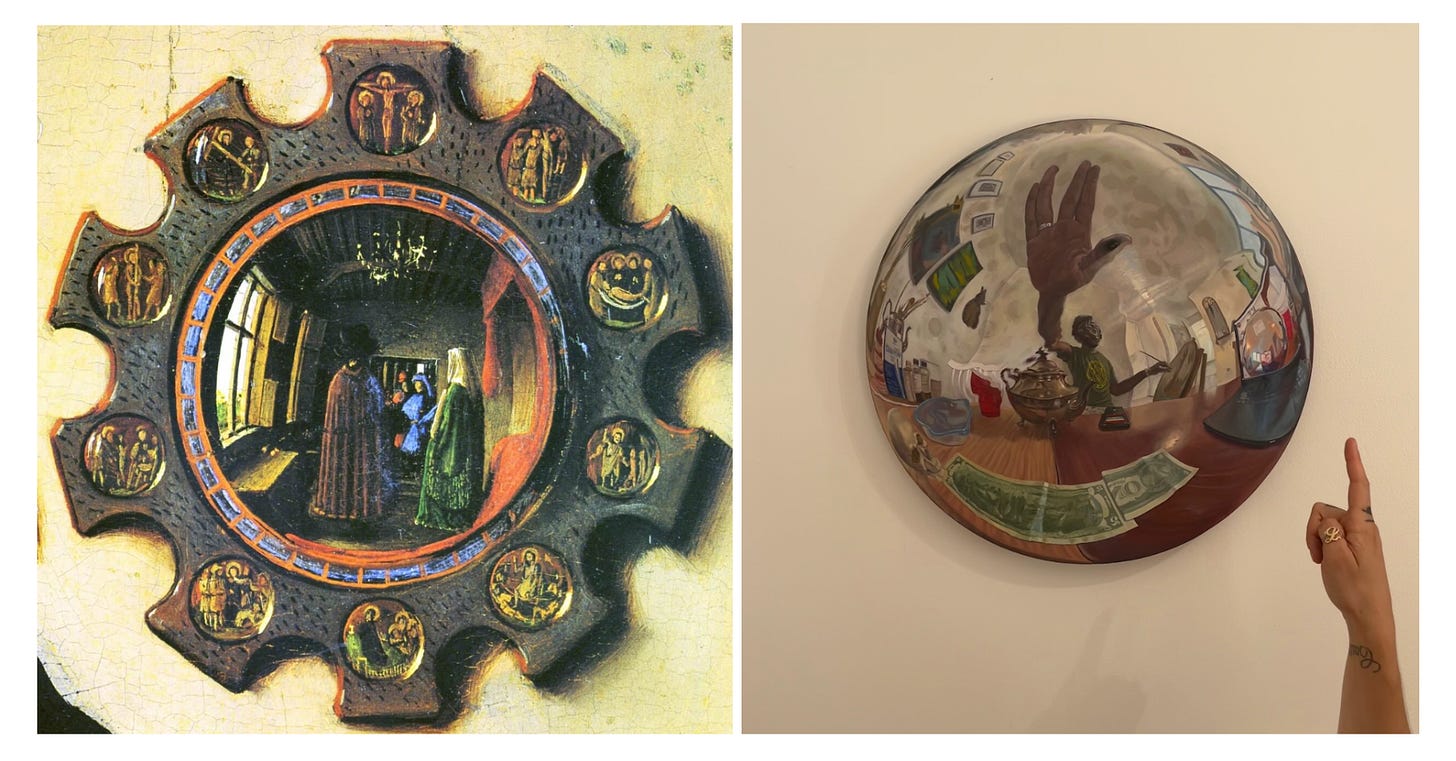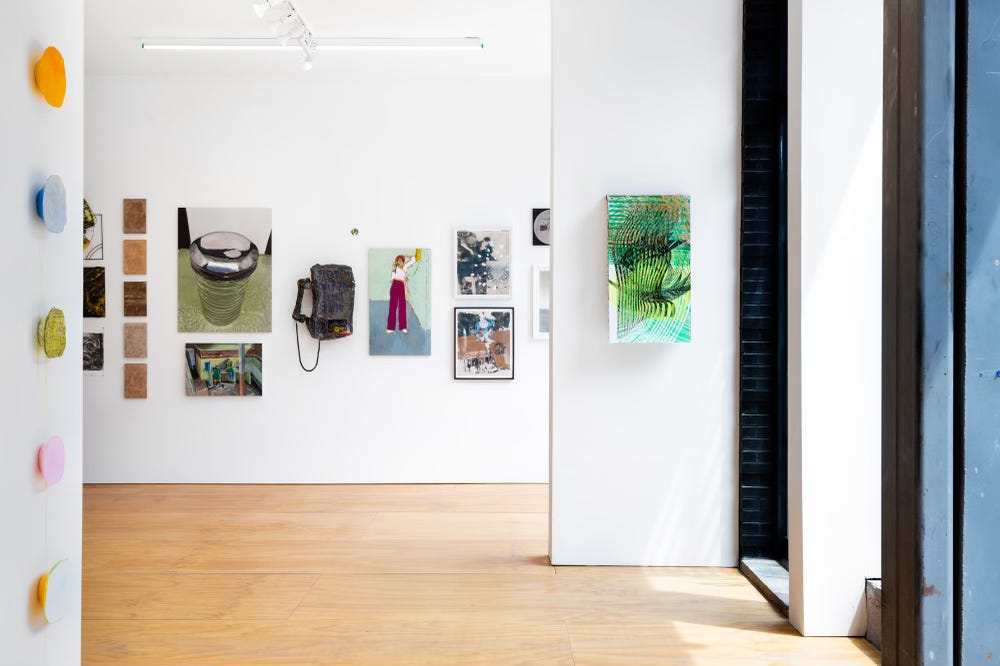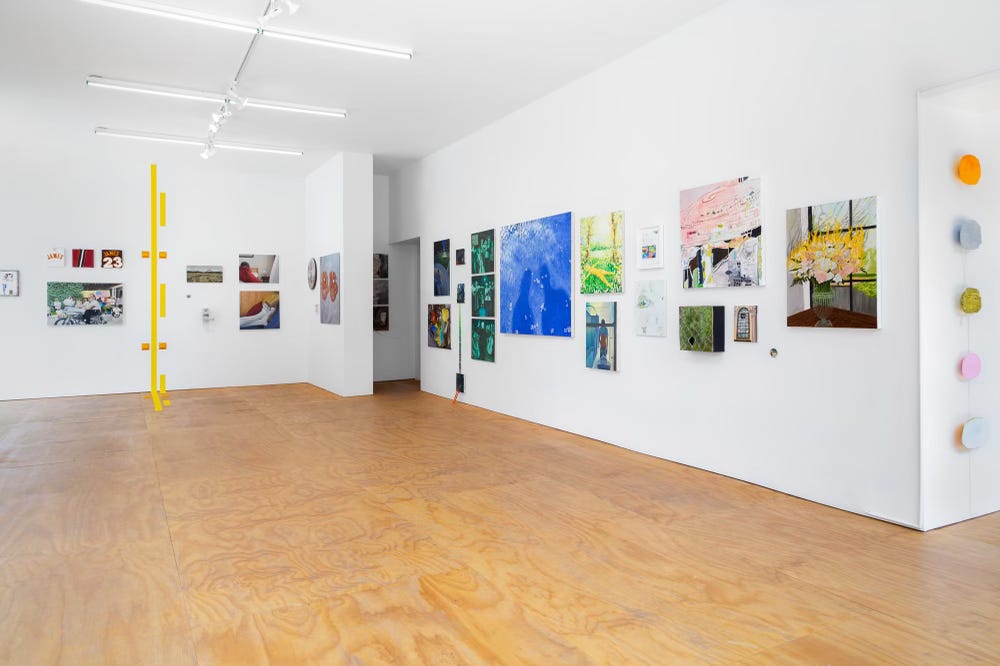Welcome to the seventeenth Poltern Newsletter 📨
This month’s issue includes a feature of the ongoing Columbia MFA Show, Otherwise, written by Anna Ghadar and featuring a note from the curator, Poltern’s own Victoria Horrocks; a piece on the junction of food and art in material and visual cultural prompted by the exhibition African/American: Making the Nation’s Table at the Africa Center and MOFAD by Hannah Kressel.
If you have any questions or comments, please reach out to us by responding to this email or writing us at polternmag@gmail.com.
Thank you for being here.
The Poltern Team
Feature | Otherwise
by Anna Ghadar
The second leg of the Columbia MFA show showcasing the 2022-2023 cohort is just about everything you’d hope it would be: engaging, subversive, and even a little tongue-in-cheek.
Otherwise is a literal representation of the word’s definition: “a different way or manner.” The loose definition allows for a wide breadth of subject matter and interpretation; in their own way, each artist reimagines the art historical canon through their own lens. The show features work by 58 MFA artists and seven faculty members and is curated by three graduate students, so there are many varying “manners” or lenses with which to contemplate the works on view.

From contemporary plays on early Northern Renaissance techniques, as seen in Kevin Cobb’s Orbicular Blurse (2022), to the show’s salon-style hang that gives a cheeky nod to the inflexible Beaux-Arts tradition of centuries past, this exhibition is filled with confrontations of the rigidity of the canon. Each work is steeped in cultural critique, both from a theoretical perspective (as MFA shows do) as well as an internal honing of each artist’s own personal style.

Exhibiting these artists’ rearticulations that inject a “personal style” into steadfast subject matter is, in theory, a simple common denominator. Each work of art, however, and their arrangement on the walls of Half Gallery, offer unique challenges to the status quo. For example, some reconsider the medium of painting through atypical application. On the first wall to the left of the entrance, you will see Sang Lee’s Untitled (2022) and Keika Okamoto’s Traveler and Yanagi Tree (2022), both of which present classically beautiful florals in tender, cool tones. However, each surface riffs on the expected perceived neutrality of oil on canvas works in a painting show. Lee’s work has thick but smooth layers of drywall overtop a wood panel and a minimalist engraving of a peony-like bloom in the lower right quadrant of the surface. Okamoto folds a small, expertly painted oil painting over the edges of the tiny stretchers to extend the verticality of the work outside of the picture plane. The interventions to what’s “expected” are minimal but impactful.
Oftentimes critics are quick to brush off early-career artists as derivative or might shrug at the notion that an MFA show is “subverting the canon.” That said, Otherwise’s ability to turn this common (and, honestly, uncreative) jab into a jumping-off point for the show adds to the fun: each artist will, of course, engage with artists and movements before them, just as each curator will reflect on an exhibition’s relation to art history. Moreover, each contributor partakes in this familiar dialogue while parsing out the nuances that breathe new life into the subject matter.

A note from the curator, Victoria Horrocks:
The “summer show” has been done, and will be done, so long as the MFA demands it. As a model, this type of exhibition is a recipe for crowded walls and suffocated artwork. Otherwise seeks to take that obstacle and use it as an operative framework. When life gives you lemons…make it salon-style. And also turn salon-style on its head. The concept is not new: Institutions from the Royal Academy in London to O’Flaherty’s in New York’s Lower East Side (just down the street from Half Gallery) are trying it. What I hope comes across in Otherwise, however, is not only an attempt to subvert canon and challenge traditional modes of viewing, but to honor the work these brilliant emerging artists have brought forth. At such rich points in their careers, they have generously shared pieces of their practices with us. While challenging the very modes and parameters of its genre, this summer show has held at its core the intention of listening to each artist and each work of art. Rather than a cacophony of discordant tones, Otherwise pursues a collective harmony, where each voice is heard among a chorus of its contemporaries.
Otherwise is curated by Carlota Ortiz Monasterio, Ho Won Kim and Victoria Horrocks and features 58 Columbia MFA artists and 7 faculty members. It is on view at Half Gallery from July 26th to August 20th.
–
Anna Ghadar is a writer and art advisor based in NYC. She recently completed her MSt in the History of Art and Visual Culture at the University of Oxford.
Victoria Horrocks is a writer and art historian currently pursuing her MA in Modern and Contemporary Art at Columbia University.
Review | African/American: Making the Nation’s Table
by Hannah Kressel

Quilting — the process of stitching multiple pieces of fabric together to create a comforter or tapestry — relies on three layers: the decorative quilted top, an insulating centerpiece called batting, and a backing piece. The quilt is formed by continuously weaving a sewing needle through all three of these layers and pulling fast, eventually creating a series of bounded padded surfaces along the bounded fabric’s face. The earliest known iteration of this method was found in Mongolia and dated between 100 and 200 AD.
In more recent history, surfaces such as these have long been a symbol and product of African American ingenuity within the United States. Quilts were first seen within African American life in the seventeenth century when enslaved women fashioned quilts from leftover fabric scraps to keep their families warm. Today, quilting has flourished within Black visual culture as a rich and lyrical medium, evoking historical and contemporary themes of life and liberation. It is fitting, then, that upon entry to the Africa Center and the Museum of Food and Drink’s latest exhibition, African/American: Making the Nation’s Table, visitors first encounter the legacy, expanse, and role of African American cuisine within American food culture in the form of a quilt.
The Legacy Quilt hangs at the entrance of the Africa Center’s Aliko Dangote Hall, beckoning visitors into the main space of the exhibition. Nearly every square of the handmade quilt’s 406 blocks feature a Black culinary icon who has played a crucial role in the development of the United States’ food history. Culinary mavens like Edna Lewis, pioneer of the modern farm-to-table movement; Leah Chase, the famed Queen of Creole; award-winning vegan chef and author Bryant Terry; and Chef James Hemings (who introduced French cuisine to American palates) are just some of the hundreds of faces who greet visitors as they enter African/American. It is as though being beckoned by a league of superheroes: these are the faces, hands, and minds who have pushed American cuisine to what it is today.
No longer relegated to spaces beyond the view of the public eye, the Legacy Quilt sets the scene for the rest of the exhibition. Standing at 14 feet tall by nearly 30 feet wide, the quilt is a meticulous introduction to the work done by the exhibition as a whole: the work of reframing and reinserting the people behind many of the great feats and accomplishments within American food culture. This is a story of the embodied culture, history, and effort of African American people––from whom, the quilt seems to assert, American food culture developed. As we enter the gallery, we are joined by some of the countless African American food and drink producers who have laid the foundation for American cuisine, not only to honor the fruits of their labor but to honor them, as well.
Like the tradition of African American quilting, African American cuisine is oftentimes spurred from humble roots: coaxing flavor and nutrients from available resources. ––However, much like quilting, Black communities contributed far more to American cuisine than thriftiness and a few choice recipes. Rather, as African/American highlights, they forged the way forward for ethical farming practices (the exhibition’s wonderful virtual reality theater features farmer and herbalist Matthew Raiford and Jovan Sage at Gilliard Farms), for modern weeknight home cooking (Ebony Magazine’s test kitchen is rebuilt for all your viewing pleasure, set to a playlist of 70s-era soul music curated by Kelis), for American whiskey manufacturing, and many other staples of the American palate including barbeque and ice cream. African/American paves a path from the fields and kitchen of slave owners, through many iconic moments of culinary ingenious, through today. The exhibition also underscores the recent admission of African American culinary achievements into “mainstream” canonical food history. Further, how their achievements are only now being understood in these settings in their full expanse. This is both a story of grounding American foodways nationally and looking with specificity at the history of Black cooking in America. This story is about the elevated flavors as well as cooking and farming practices that provide the backbone for food culture in the United States today.
African/American: Making the Nation’s Table is a wonderful introduction to the many ways African Americans have shaped the American culinary experience and a must-visit for all those who concern themselves with food, farming, and, frankly, eating, in America. The exhibition was curated by Dr. Jessica B. Harris in conjunction with an advisory committee of over 30 visionaries within the Black American culinary landscape.
—
[1] https://www.nytimes.com/1992/01/26/nyregion/what-quilting-means-to-black-women.html
Hannah Kressel is an art historian and writer located in New York City. She currently works as a litigation assistant focusing on art law matters.
Please follow us on Twitter and Instagram (@poltern_) for updates and share our newsletter with anyone who might be interested.










